The Economics and Statistics Division maintains archives of previous publications for accountability purposes, but makes no updates to keep these documents current with the latest data revisions from Statistics Canada. As a result, information in older documents may not be accurate. Please exercise caution when referring to older documents. For the latest information and historical data, please contact the individual listed to the right.
<--- Return to Archive
For additional information relating to this article, please contact:
April 09, 2018MULTIFACTOR PRODUCTIVITY GROWTH IN THE PROVINCES, 2016 Statistics Canada has released its provincial multifactor productivity and related variables for the business sector for 2016. Multifactor productivity measures are derived using a growth accounting framework that includes measures of how capital input and skills impact labour productivity growth. The residual portion of labour productivity growth that is not attributable to other factors is the multifactor productivity(MFP) measure. The multifactor productivity captures the efficiency by which inputs are used in productions, these can be associated with technological change, organizational change or economies of scale.
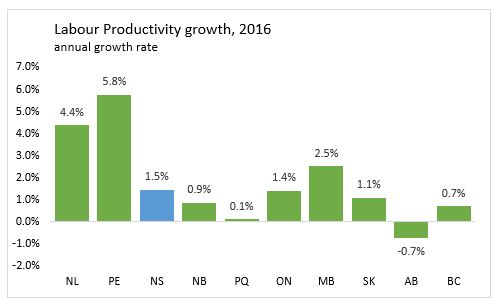
Labour productivity growth grew 1.5 per cent in Nova Scotia in 2016. Labour productivity growth was fastest in Prince Edward Island (+5.8%) and Newfoundland and Labrador (+4.4%) while declining in Alberta (-0.7%).
The growth in labour productivity can be decomposed into contributions from capital intensity (capital investment's effect on productivity), labour composition (education and experience effect) and the multifactor productivity that accounts for all other factors including technological change and changes in economies of scale. In 2016, multifactor productivity increased 0.7 per cent in Nova Scotia. Multifactor productivity decreased in Alberta (-3.8%), Newfoundland and Labrador (-3.5%), and Saskatchewan (-0.5%).

Across Nova Scotia business sector, average labour productivity growth was 4.5 per cent in the goods sector and 0.2 per cent in the services sector in 2016. Labour productivity in the agriculture, forestry and fishing declined 4.5 per cent with a decrease in multifactor productivity. Mining and oil and gas extraction productivity was up with a large increase in the capital intensity. Manufacturing and construction both had increases in multifactor productivity and overall labour productivity. Multifactor productivity (-0.7%) declined in the service sectors with most subsectors seeing decreases. Within the business service sector, capital intensity increased 0.7 per cent and labour composition grew 0.2 per cent in 2016.
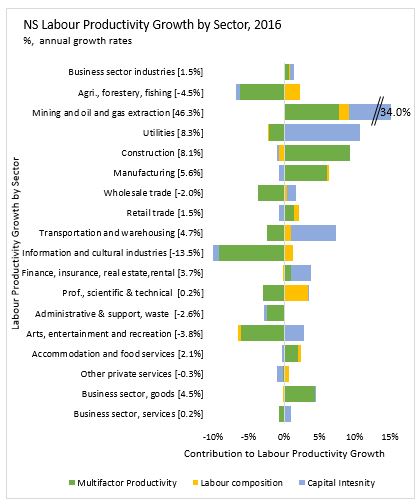
Over the period 1997-2016, Nova Scotia's labour productivity grew at an annual average rate of 0.8 per cent. The fastest labour productivity growth was in Manitoba and Newfoundland and Labrador while the slowest was in Alberta.
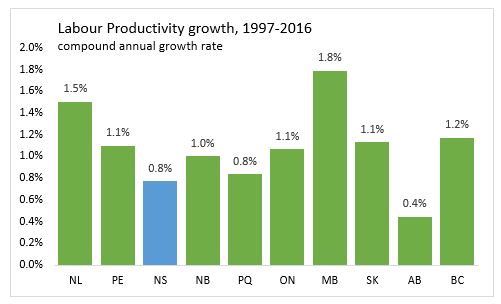
Over longer periods of time, the composition of labour productivity growth looks different than for a single year. For all provinces, except Ontario, the largest source of labour productivity growth over the 1997-2015 period come from growth in capital intensity. Changes in labour composition on average make a small and positive contribution to labour productivity. Multifactor productivity declines offset significant portions of growth in Saskatchewan and Alberta.
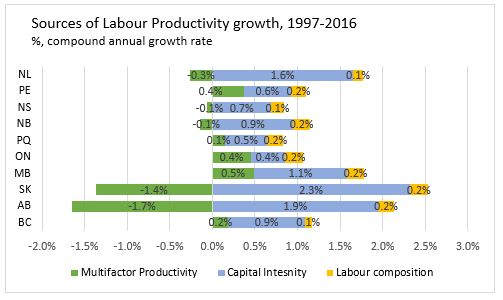
From 1997 to 2016, labour productivity increased 1.3 per cent per year in the goods-producing sector and 0.6 per cent per year in the services-producing sector. Productivity in the agriculture, forestry, fishing and manufacturing sectors increased due to multifactor productivity while mining, oil and gas extraction and utilities saw growth coming from greater capital intensity. Services-producing labour productivity growth was the result of increase in capital intensity (+0.9% per year) and labour composition (+0.2% per year) offsetting a decline in multifactor productivity (-0.5% per year). Capital intensity and labour composition increased on average in all service sectors over the 1997-2016 period.
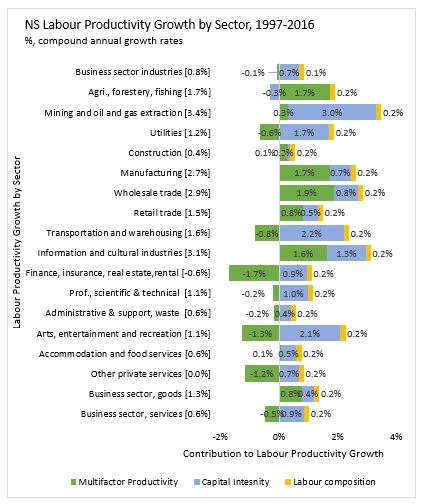
Estimates of multifactor productivity growth in the provinces, 2016
<--- Return to Archive